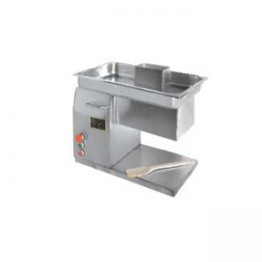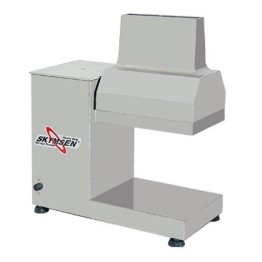Meat Tenderizers

Meat Tenderizers
What Are Meat Tenderizers?
When we talk about meat tenderizers, we're discussing tools or ingredients that make meat more palatable by softening the fibres and connective tissues. These can be physical tools like mallets or blades, or they can be natural or chemical substances that achieve the same effect. A tenderizer makes the meat not only easier to chew but also helps it cook more evenly and absorb more flavour.
The process of tenderization is particularly important for tougher cuts of meat. These cuts often come from the parts of the animal that do more work, like the shoulders or legs. Tenderizers break down the complexity of these muscles, transforming an otherwise chewy steak into a tender delight. This is crucial for dishes where the texture of the meat is paramount to the dining experience.
Understanding the science behind meat tenderization can elevate your culinary skills. It involves a bit of chemistry and physics, but fear not, as we'll guide you through the various methods available to ensure your meat is perfectly prepared every time. This will not only enhance your cooking but also expand the range of recipes you can confidently tackle.
Why Use Meat Tenderizers?
Using a meat tenderizer is about more than just ensuring a soft bite; it's about unlocking the full potential of your dish. Tenderizing meat allows for a more even cook, as tougher meats can end up undercooked in some areas and overcooked in others if they are not properly prepared. This is especially true for methods like grilling or frying.Moreover, tenderizing meat increases its ability to absorb marinades and spices, which is essential for flavourful dishes. The physical or chemical breakdown of the meat's structure creates channels for these flavouring agents to penetrate beyond the surface, infusing every bite with depth and character.
Lastly, there's the matter of digestibility. Tenderized meat is easier on the stomach since much of the work has already been done prior to consumption. This means a more enjoyable meal and a happier digestive system post-dinner, especially for individuals who may have difficulty with tougher textures.
Different Types of Meat Tenderizers
Manual Meat Tenderizers
The most commonly recognized tenderizer is the mallet-style meat tenderizer. Often made from wood or metal, this tool features a weighty head with a spiked or flat end that you pound meat with to break down the fibres. It's an effective method, but it requires a bit of muscle and can get messy.Blade tenderizers are another manual option. These have multiple blades that you press into the meat, creating small heat channels that help with cooking and absorption of flavours. Blade tenderizers are less labor-intensive than mallets and are excellent for thicker cuts.
Rolling tenderizers are somewhat of a hybrid, with small blades on a wheel that rolls across the meat, achieving similar results to the blade tenderizer but with a motion more akin to rolling out dough. They're convenient and less physically demanding than mallets.
Mechanical Meat Tenderizers
In commercial settings, or for the home cook who wants to streamline their process, mechanical tenderizers are available. These machines can process larger quantities of meat quickly and with consistent results. They work by using sharp blades or needles to puncture the meat as it passes through a press or roller.These mechanical tenderizers are a significant investment, but for those who process a lot of meat, they can be a worthwhile addition to the kitchen arsenal. They ensure an even degree of tenderization that can be harder to achieve manually.
Natural Meat Tenderizers
Moving away from the physical tools, there are also natural meat tenderizers. These are ingredients found in your kitchen that can soften meat fibres. Fruits like pineapple, papaya, kiwi, and figs contain enzymes that naturally break down protein. For example, papain from papaya is a popular tenderizing agent.These fruits can be used in marinades or as a rub. However, they must be used with care, as their enzymes are so effective they can turn meat mushy if left too long. It's a delicate balance but mastering the use of natural tenderizers can add a unique twist to your dishes.
Chemical Meat Tenderizers
Lastly, we have chemical tenderizers, which are typically powders that you sprinkle on the meat before cooking. These often contain enzymes similar to those found in natural tenderizers, like bromelain from pineapple or papain mentioned earlier. They are designed to be more controlled and less likely to over-tenderize the meat.Chemical tenderizers are convenient and easy to use, making them a great option for those who are short on time or new to the tenderizing game. They're widely available in supermarkets and don't require any special storage considerations.
How To Tenderize Meat Properly
Tenderizing meat is not just about hammering away at a steak or sprinkling on some magic powder; it requires technique and timing. When using a mallet, the key is to strike with even, measured blows, covering the entire surface area of the meat. This ensures uniform tenderness.For blade tenderizers, it's important to press down firmly and evenly, covering the meat in a grid-like pattern. This method requires less brute force than a mallet but still demands attention to detail.
When using natural or chemical tenderizers, timing is everything. Adhere to the guidelines for how long to leave the tenderizer on the meat. Overdoing it can result in an undesirable texture, so always monitor the process closely.
Tips For Using Meat Tenderizers Effectively
To get the most out of your tenderizer, start with room temperature meat. This helps the fibres break down more easily and the meat absorb marinades better. Always tenderize before you season or marinate, as this opens up the meat to receive more flavour.If using a mallet, place the meat between sheets of plastic wrap or in a sealed bag to prevent splatter and cross-contamination. When using natural tenderizers, puree or crush the fruits to release the enzymes and apply them to the meat directly or in a marinade.
After tenderizing, let the meat rest. This is particularly important for chemical tenderizers, which need time to work their magic. A few minutes can make all the difference between an okay steak and a phenomenal one.
Recipes That Benefit From Meat Tenderizers
Tough cuts like flank steak, chuck, or brisket are prime candidates for tenderizing. Tenderized flank steak is perfect for fajitas or stir-fries, where quick cooking and full flavour are desired. A tenderized brisket can transform a slow-cooked stew or barbecue.Even poultry can benefit from tenderizing. Chicken breasts, often prone to drying out, can retain more moisture and flavour when tenderized. This makes them excellent for grilling or pan-frying.
Pork chops are another great example. A tenderized pork chop can better withstand the high heat of a grill or skillet, resulting in a juicier, more flavourful dish.
Common Mistakes To Avoid When Using Meat Tenderizers
One common mistake is over-tenderizing. This can lead to a mushy texture that's unappetizing. It's important to know when to stop, whether you're using a manual tool or a chemical tenderizer.Another error is uneven tenderizing. This can result in parts of the meat being perfectly tender while others remain tough. Consistency is key to a well-prepared cut.
Lastly, not all meat needs tenderizing. Some cuts are naturally tender and overdoing it can ruin a perfectly good piece of meat. It's important to assess each cut individually and decide whether it will benefit from tenderizing.
Conclusion
Meat tenderizers are a crucial tool in the arsenal of any cook looking to master the art of meat preparation. From the humble kitchen mallet to sophisticated chemical tenderizers, there's a method suited to every level of cooking expertise. The key is understanding the how and why behind the tenderizing process.By following the tips and techniques outlined in this article, you can ensure that your meats are always perfectly tenderized, resulting in dishes that are both delicious and digestible. So go ahead, experiment with different tenderizers and recipes, and elevate your cooking to a delectable new height.
Meat tenderizers can turn a good meal into a great one, transforming tough cuts into succulent, flavourful delights. With a bit of practice and patience, you'll find the method that works best for you, and your taste buds (and dinner guests) will thank you for it.
Gatto Meat Tenderiser
Gatto Meat TenderiserVoltage: V 220Power: W 550Weight: KG 35Dimension: MM 530X850X1650• Stainless st..
R24,146.22 R32,194.96 Ex Tax: R24,146.22
Tenderizer Skymsen - S/Steel
Tenderizer Skymsen - S/Steel. Use For Tenderised Steak In Restaurants, Supermarkets Etc.Ideal For Th..
R32,785.88 R43,714.51 Ex Tax: R32,785.88
Tenderizer Skymsen - Stripcutter Attachment - 12mm
Tenderizer Skymsen - Stripcutter Attachment - 12Mm...
R8,814.12 R11,752.16 Ex Tax: R8,814.12
Showing 1 to 3 of 3 (1 Pages)



